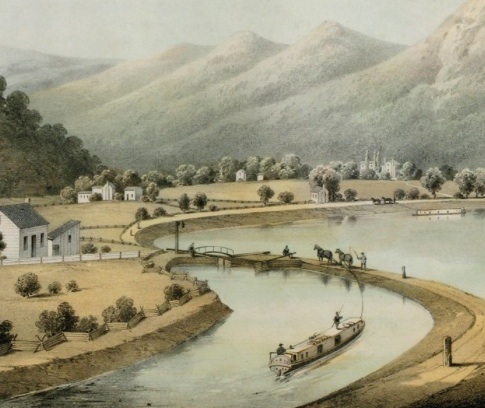This blog focuses on Virginia’s Antebellum economy. Like other border states, it grew apart from the Deep South mono-agricultural economies before the Civil War, though not at the frenetic changes of the magnitude seen in the North. To begin we look at Virginia’s “Urban Growth in the Age of Sectionalism” and at the comparative economic development at two failed canals in Albemarle County, Virginia and Cumberland County, Pennsylvania, in “A House Dividing”.
Virginia’s industrial development and decline can be seen in “Coal, Iron and Slaves”. Its failed commitment to canals over railroads is documented in “Cabell’s Canal”. The connecting influences of the railroad and regional and world commercial markets are explored in “Southwest Virginia’s Railroad”.
These books are all used in bibliographies found in peer-reviewed surveys of Virginia history of scholarly merit. Additional insights are used from articles in the Virginia Magazine of History and Biography, the Journal of Southern History and the Journal of American History.
For book reviews at The Virginia Historian.com in this historical period addressing other topics, see the webpage for Antebellum, Civil War, Reconstruction. General surveys of Virginia History can be found at Virginia History Surveys. Other Virginia history divided by topics and time periods can be found at the webpage Books and Reviews.
Urban Growth in the Age of Sectionalism

Daniel Goldfield wrote Urban Growth in the Age of Sectionalism: Virginia, 1847-1861 in 1977. It is available in paperback new and used. Virginia’s sectionalism inspired leaders, including some planters, to promote commerce, trade and urbanization by investing in banking, railroad and manufacturing. Though growing at slower rate than New York City, Virginia cities had accelerating growth and prosperity following the Mexican War.
In this study of Richmond and Petersburg, Norfolk and Alexandria, Lynchburg and Wheeling, Goldfield explains how the “city builders” of a civic elite developed a conscious southern urban civilization. But in its close integration with the slave-holding hinterland, it was related to sectionalism. Learn more to buy “Urban Growth” here for your bookshelf.
A House Dividing

John Majewski wrote A House Dividing: Economic Development in Pennsylvania and Virginia before the Civil War in 2000. It is now available in paperback. Virginians prospered before secession, but they grew without developing entirely as a state because slave-holding interests proved to be an insurmountable obstacle to entrepreneurial plans. The book details an analysis of two failed canal companies in Albemarle County, Virginia and Cumberland County, Pennsylvania.
Both counties were nearby major cities (Richmond, Philadelphia). But Virginia never developed an integrated transportation centered on a single place, Tidewater slavery and slave interests enforced smothering policies that retarded development among both Piedmont slave-holding counties nearby Richmond, and free labor counties west of the Blue Ridge. Learn more to buy “A House Dividing” here for your bookshelf.
Coal, Iron and Slaves

Ronald Lewis wrote Coal, Iron and Slaves: Industrial Slavery in Maryland and Virginia in 1979. It is out of print, but available online new and used. The study traces the rise and fall of iron and coal production in the Chesapeake and Piedmont from British imperial suppliers beginning in 1717, through new nation competition and its demise at the Civil War. Both state legislatures offered little support, and there was little innovation in new management procedures or technological advances.
Slaves continued to be used when their hiring costs rose relative to free white laborers, further marginalizing competitive advantage. The “overwork” system gained slaves material progress amidst labor relations of “forced compromise”, but still the industry was plagued by violence against masters and runaways. Learn more to buy “Coal, Iron and Slaves” here for your bookshelf.
Cabell’s Canal

Langhorne Gibson, Jr. wrote Cabell’s Canal: The Story of the James River and Kanawha in 2000. It is out of print but available online used. The title character is Joseph Carrington Cabell, who raised millions in private subscriptions and millions in legislature financing to promote the dream of a James River Canal. He advanced the dreams of visionaries such as Jefferson and Washington.
Several canal and lock proposals were funded by joint public and private schemes and failed, most notably at the resignation Napoleonic engineer Claudius Crozet who in turn promoted railroads. Cabell successfully retarded Virginia’s railroad development in the legislature until the 1850s, when rail mileage trebled in a decade. Learn more to buy “Cabell’s Canal” here for your bookshelf.
Southwest Virginia’s Railroad

Kenneth W. Noe wrote Southwest Virginia’s Railroad: Modernization and the Sectional Crisis in 1994. It is now available in paperback. The Virginia and Tennessee Railroad from Bristol, Tennessee to Lynchburg with connections to Richmond, transformed the regional economy in the 1850s. It promoted a commercial slave-based economy of tobacco and wheat, along with extractive industry and hot springs tourism.
The developments made for an “iron road to secession”, breaking the former political commonalities with other western Virginia counties. Learn more to buy “The Edge of the South” here for your bookshelf.
Appalachian Frontiers

Robert D. Mitchell edited Appalachian Frontiers: Settlement, Society and Development in the Preindustrial Era in 1991. It is out of print but available online used. The anthology explores the commercial tendencies inherent in the region’s land tenure, agricultural output including cattle export, mercantile operations of trading posts and itinerants, and a diverse social structure.
Appalachia in the pre-industrial antebellum period should be viewed as a place in process undergoing recognizable changes. But instead of identifying a retarded development, Mitchell sees a prolonged stage of subsistence agragrarian forms. Learn more to buy “Appalachian Frontiers” here for your bookshelf.
For book reviews at The Virginia Historian.com in this historical period addressing other topics, see the webpage for Antebellum, Civil War, Reconstruction. General surveys of Virginia History can be found at Virginia History Surveys. Other Virginia history divided by topics and time periods can be found at the webpage Books and Reviews.

